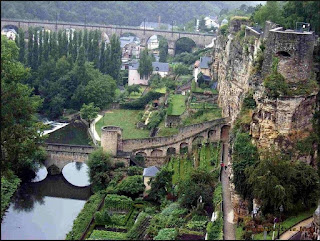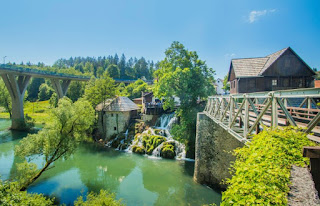I was also provoked by
the logic of travel to visit the largest of the dwarf states in Europe: I like
to dilute long journeys with stops for sightseeing. Luxembourg in this case
came across just on the way from the North Sea coast to Dusseldorf, where we had
to rent a rental car and put it home. And although there was a hefty detour on
the route, I considered him to be tolerant: all the cities along the road, such
as Maastricht, Liege, Namur, I saw, which means that it was necessary to
replenish the baggage of impressions with something new.
No, strictly speaking, I had already had the opportunity to visit the territory of the Grand Duchy, but only a few hours drive, and definitely should have seen the sights of Luxembourg more thoughtfully. So I decided to get to the ducal capital and enjoy its beauty slowly, to the full.
No, strictly speaking, I had already had the opportunity to visit the territory of the Grand Duchy, but only a few hours drive, and definitely should have seen the sights of Luxembourg more thoughtfully. So I decided to get to the ducal capital and enjoy its beauty slowly, to the full.
Here are just my plans remained plans, because on
arrival at the place of work went awry. Calculating time, I decided that, as
usual, we would park somewhere near the city center and calmly walk. The
reality turned out to be different: there are major problems with parking in
Luxembourg.
And the history of
Luxembourg began in a very masculine way: the foundation of the future state
was laid in 963, when the powerful fort of Lisilinburg was erected on the
remains of an ancient Roman fort. Its owner, Count Siegfried, managed to retain
sovereignty over the surrounding territory in the struggle against the Holy
Roman Empire, having founded the Luxembourg House. His descendants tried to continue
the line of independence, and even achieved that in 1354 the county of
Luxembourg turned into a duchy, rising to a higher level. Problems began later,
towards the end of the Middle Ages. At first, the powerful dukes of Burgundy,
then on equal terms with the French kings, grabbed foreign possessions. Luxembourg
tried to stay away from the confrontation between Spain and the rebels of the
Netherlands, but its inhabitants failed to avoid the horrors of the Thirty
Years War. Next were the French, followed by the Spaniards, and again the
French, and again the Spaniards. France at one time tried to gain a foothold in
the occupied lands seriously, and the local fortifications were built by the
great Vauban himself, but another peace treaty concerning the so-called Spanish
inheritance, gave power over Luxembourg to Austria. Napoleon swatted the
dukedom in disguise and did not notice, but then, at the Congress of Vienna,
the diplomats had to suffer, deciding what to do with this corner of Europe.The German princes were pulling the blanket over themselves; the neighboring Netherlands also wanted to expand their territory. Luxembourg was eventually proclaimed the Grand Duchy under the rule of the Dutch king Willem I. The status of an independent state of the land at the junction of Belgium, Holland and Germany was received at an international conference in 1867, when great powers, including the Russian Empire, declared Luxembourg a neutral country with a hereditary monarch from home nassau. Neutrality was twice violated by German troops during both World Wars, then the Grand Dukes themselves violated neutrality, making the country in 1949 a member of NATO. Another important step in the actual renunciation of sovereignty was the entry of Luxembourg into the European Union, which was at that time the European Coal and Steel Union; the headquarters of the new institution were located in the Luxembourg capital, and only much later did the European bureaucrats move to Brussels.
At least there are already half a dozen mosques, and
the Muslim community is growing. So, you see, soon, as in neighboring Belgium,
there will be a party of sharia lovers, and there it is not far from before the
introduction of sharia law. That's just how the promotion of Islamists will be
combined with the indulgence of same-sex relationships, for me personally, a
mystery - it is necessary to contrive either those or these not to offend.
From the fortress bastions,
a colossal bridge bearing the name of the Grand Duchess Charlotte is also clearly
visible. Personally, in her place I would be careful not to leave the memory of
myself in a similar way: the building is completely inconspicuous and fits into
the landscape of Luxembourg in much the same way as a cow cake on a festive
table. And after all, they built a crossing according to the project that won
the competition for dozens of others - what were they like ?!
The eastern end of the Duchess Charlotte Bridge goes
into new areas, bristling with skyscrapers. This is also not the best sight, so
it is much more reasonable to take a course to the west, in the depth of the
historical buildings. Then almost immediately the stylish church of
Saint-Michel will come across. It is considered the oldest surviving temple in
the country, some stones of its walls and foundation have been in place since
the end of the 10th century.
The temple was rebuilt and modified several times, the
look that now appears to the viewer is a mixture of Baroque and Romanesque
styles of architecture that finally took shape more than three hundred years
ago. There is nothing particularly exciting inside, so if you admire the old
building from the outside, you have to go on to look at other sights of
Luxembourg. This will not be the case: the National Museum of the country is located
right to the right, and if you walk a couple of blocks forward and up Rue
Sigefroi, then the Ducal Palace will be found around the left corner.
Strictly speaking, the complex of nice buildings was
not originally intended for the placement of crowned heads, from 1572 to 1795
it was occupied by ordinary city officials. The fate of the palace experienced
a sharp turn later, with the establishment of the power of the Netherlands,
when the governor of the Dutch king chose the building for the residence. Finally,
the Groussherzogleche Palais, as its name in the local dialect sounds in the
hands of the highest authority, came in 1890, and has since been used as the
official residence of the Grand Dukes of Luxembourg. For their convenience, a
new wing was added and the interiors were replaced.
Honestly, although
the facade looks nice, you can easily walk past it, because there are plenty of
pleasant-looking buildings in Luxembourg. The value of this particular
architectural ensemble is issued except for the soldiers of the guard of honor
near the entrance. The last time we saw one such guard, cold and sniffy. The
current entry did not allow seeing any guards at all, the guard rooms were
empty. Theoretically, anyone can visit the Palace of the
Great Dukes of Luxembourg as part of the tour, such as tours are organized on
weekdays in August and early September, but I could not get accurate
information on this subject. So for now, the most reliable option to see the
palace interiors is a visit as part of the official delegation: the ducal
guests are accommodated in the residence.
Summing up our tour of Luxembourg, I can say that I
value the capital of the Grand Duchy as a C grade. It is, of course,
interesting and has an ancient history, only its modern look in many ways
repels rather than attracts. First of all, at the thought of a tiny country, I
recall couples in love with homosexuals, then parking problems, then hordes of
immigrants. Again, we still could not find a place to eat cheaply in
Luxembourg.





No comments:
Post a Comment